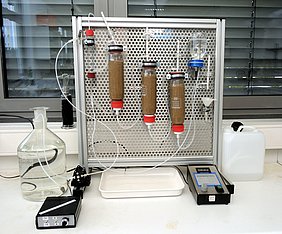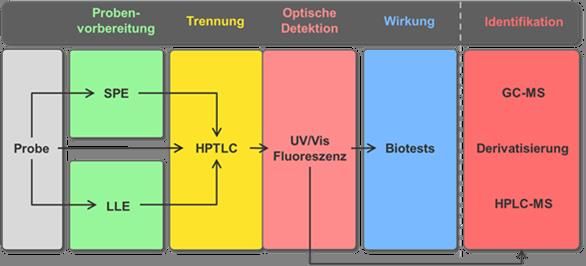Effect-related analysis (WBA - wirkungsbezogene Analytik) is an important addition to exposure analysis. In contrast to the assessment of total effects of standardised biotests, combining a separation process with in vitro biotests makes it possible to assess the effects of individual fractions.
Chemical analytics is able to detect trace quantities of a wide range of organic micropollutants. However, at present it is not possible to identify all the micropollutants present in a water sample, which would permit a full toxicological assessment. As, besides hygienic safety, water suppliers place top priority on the toxicological safety of the dispensed water, methods are required to establish the effects of the micropollutants in water. Effect-related analysis (WBA - Wirkungsbezogene Analytik) is an important addition to exposure analysis.
In the WBA, for example, the separation method of high-performance thin-layer chromatography (HPTLC) is paired with in vitro biotests which has the advantage over standardised biotests that the effects of individual fractions of the sample can be investigated rather than the overall effect. Additionally, substance characterisation of the effective bands can be performed via physical-chemical analysis, which enables a more differentiated statement on the cause of a detected effect.
The aim of this project, which was funded by the DVGW, was to show the possibilities and significance of the effect-related analysis for the field of water treatment. Researchers investigated to what extent effect-related analysis can be used to assess the behaviour of micropollutants in drinking water treatment processes.
A method was developed to investigate samples with real micropollutant concentrations for their effects. Besides experiments that simulated treatment using continuous ozonation combined with a biologically active slow sand filtration, real water was studied from 11 water suppliers across the whole of Germany. The developed method (enrichment + effect-related analysis) and its evaluation provided results both in the lab experiments and from testing real samples, that provided insights into the effectiveness of the used treatment processes. The aim of the project was therefore achieved.

![[Translate to English:] Prüfstelle-Produktprüfung_Teststand Test centre and product testing](/fileadmin/_processed_/0/9/csm_TZW-Karlsruhe_Pruefung_Geraete-Teststand_377188946c.jpg)

























